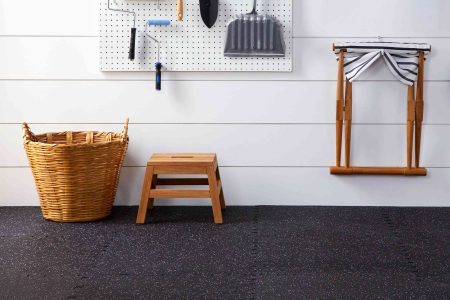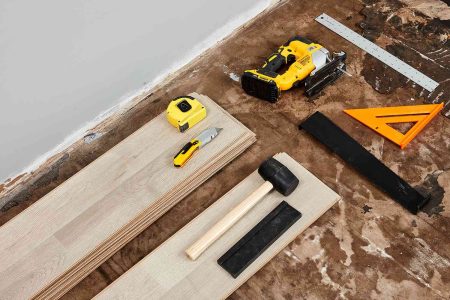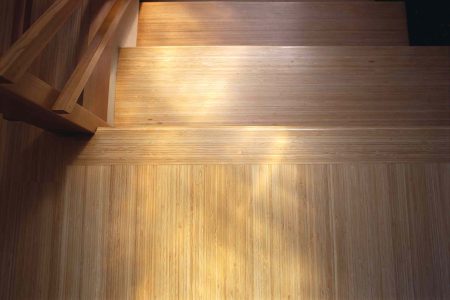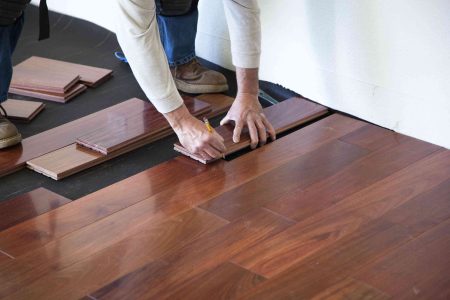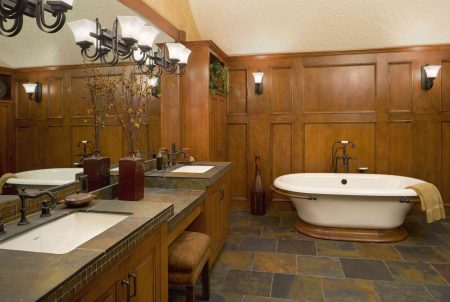Consider this familiar scenario: You’re doing a full-scale remodel of your kitchen and everything in your kitchen is coming out and getting replaced, including the walls, cabinets, flooring, and appliances. When installing, do cabinets or flooring come first? The answer depends on what type of flooring you have—vinyl, laminate, wood, or tile—and if the cabinet and subfloor already meet the height of standard cabinets.
If the height is met, vinyl and laminate flooring can either come after the cabinets, and be installed right up to the base, or run underneath both the cabinets and the appliances, due to its thin structure. But thicker floors—like hardwood and tile—can come before the cabinets and may need to be installed right on top of the subfloor to achieve standard cabinet height.
Our guide shows you how to put the puzzle pieces back together correctly (cabinets of flooring first), barring your specific construction details.
When to Install Cabinets Before Flooring
In most cases, given standard flooring heights, you will install the cabinets or kitchen island before the floor covering. You will also install flooring before appliances. Floor covering, or finish flooring, is the surface that you see and walk on—not the subfloor, or the underlayment—and can include laminate and vinyl materials or wood and tile options. The floor covering should be cut to size and butted up against the cabinets or island, leaving a minimal gap between the flooring and the cabinets. This gap will be covered by baseboard or shoe molding that is nailed to the bottom of the cabinets’ base.
Installing Cabinets Before Flooring
-
Uses less flooring material
-
Minimizes the floor height
-
Reduces potential for damage
-
You’re bound to a specific footprint
-
Installation is time-consuming
-
Can be more expensive
Types of Kitchen Flooring and When to Install Them
- Vinyl: Vinyl can be installed after the cabinets if the subfloor, underlayment, and cabinet height together achieve the standard height of 34 inches to 36 inches.
- Laminate: Laminate flooring can be treated exactly like vinyl flooring and installed after the cabinets if standard height measurements are met.
- Hardwood: Harwood flooring can be installed after cabinets, only if the cabinet height is met. However, many carpenters install this thicker flooring on top of the subfloor to help achieve standard heights.
- Tile: Tile flooring should go under the kitchen cabinets, and should be treated the same as hardwood, depending on the finished cabinet height.
Note: Floating floors should not be installed under cabinets because they may shift and cause cabinets to move.
You’ll Use Less Finish Flooring
Installing kitchen base cabinets before flooring can be a money-saving advantage. For example, most of the costly hardwood flooring is usually placed, sight unseen, underneath the cabinets. So, why pay top dollar for imported hardwood that remains hidden? To keep the floor flush, consider installing a different, cheaper type of flooring underneath the cabinets and appliances, or use plywood risers.
You’ll Minimize Flooring Height
You may want to keep your existing cabinets and appliances, but the flooring still needs replacing. Consider installing thin flooring, like luxury vinyl or laminate flooring, which can be laid right up to the cabinets. The cut edge of the flooring is then covered with quarter-round or base molding.
Thicker types of flooring, like solid hardwood and tile, are trickier to work with to achieve a standard cabinet height of 34 inches to 36 inches. To address the issue of placing hardwood flooring before or after the cabinets, you can do one of two things:
- Use engineered wood flooring rather than solid hardwood. Engineered wood is a “sandwich” of wood veneer on top of high-grade plywood, and is slightly thinner than solid hardwood.
- Lay the tile or wood flooring straight onto the subfloor without an additional underlayment. An underlayment adds another 1/4 to 1/2 inch to the total flooring thickness.
When To Install Flooring Before Kitchen Cabinets
If, due to design circumstances (for example, an odd appliance height or construction anomaly), your total flooring height needs to be elevated, you can install flooring before appliances, kitchen cabinets, and the kitchen island to make up the difference. Use the flooring’s thickness (sometimes 2 inches or more) to make up for the lost height due to the anomaly. Another way to achieve this without wasting flooring is to add plywood risers underneath the cabinets and appliances.
Installing Flooring Before Cabinets
-
Corrects construction anomalies
-
Achieves standard countertop height
-
Saves money
-
Could lead to floor damage
-
Shifting floor could move cabinets
-
Wastes flooring material
Warning
Dripping paint on kitchen flooring, such as textured or linen-look porcelain tile, can be disastrous because it’s difficult to remove. Though you can more easily remove a paint drip on pre-finished wood, it will be difficult if it lands in a seam or if the paint pigment stains the wood. The bottom line: Paint before floor installation.
Read the full article here




